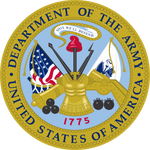
The United States Army are the ground-based armed forces of the United States. Founded on 14 June 1775 during the American Revolutionary War's first few weeks, the US Army developed into the world's most-powerful armed forces, with $668,000,000,000 being spent on the US Army as of 2015. Currently, the US Army has 490,047 active personnel and 557,246 US National Guard troops.
History[]
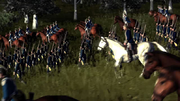
The Continental Army during the American Revolutionary War.
The US Army originated as the Continental Army, which was founded on 14 June 1775, during the American Revolutionary War. The Continental Army of the Thirteen Colonies rebelled against Great Britain, and after eight years of warfare with the British, the Americans defeated the British, forcing them to retreat from their former colonies and allowing the new United States to be independent from the British Empire. The US Army was formally created on 3 June 1784 by the Congress of the Confederation to succeed the Continental Army, which was disestablished in 1783 after the revolutionary war ended.

The US Army's first action after the Revolutionary War was against Americans, killing four rebellious farmers in the state of Pennsylvania during the "Whiskey Rebellion" of 1791-1794. Led by President George Washington himself, the army put down the rebellion, and the US Army developed into a professional fighting force after having several wars with Native American tribes from 1775 until 1890. They fought the Indians (allied with the British until the War of 1812's end in 1815) very often as the United States expanded westwards.
Foreign wars[]
The first foreign war fought by the US Army took place in Libya during the First Barbary War of 1801 to 1805, with the Battle of Derne showing how 54 American soldiers could hold off 4,000 Ottoman troops. The Americans also showed off their self-sufficiency during the War of 1812, defeating Great Britain by itself in a three-year war that involved several battles in the South, in Canada, and on the East Coast. The US Army was no longer doubted by other countries, and in 1846, they fought another war against a neighboring country in the Mexican-American War. The American forces of Zachary Taylor and Winfield Scott were constantly victorious against the armed forces of Mexico, resulting in half of Mexico being given to the United States. After the war, they consolidated control of their territories in the Utah War and Cortina Troubles.
Civil War[]
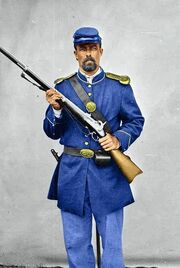
Union army uniform during the American Civil War
On 4 February 1861, the US Army was divided when the Confederate States of America, an alliance of eleven slave states in the south, seceded from the United States and formed their own new country. On 12 April 1861, following the surrender of several Union forts in the south to the Confederates, the CSA declared war on the Union and bombarded Fort Sumter in Charleston, South Carolina. The battle did not have any dead aside from Daniel Hough, who was killed by an accidental gunpowder explosion in the Union fort. The battle began the American Civil War, a brutal conflict that divided the country.
The army of the Union (the North) was much stronger than the south, as 99% of weapons were manufactured in the North, while they also had more industry and production than the South. The South mostly had agriculture, with Virginia being the most industrialized state in the south. The war nevertheless lasted for four years, ending on 9 May 1865, a little over four years after the conflict began. The surrender of the Confederacy ended the war, and the South was divided into five military districts, each with a general commanding them.
Colonial warfare[]
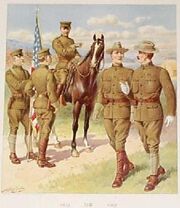
US troops in 1887
The Civil War, the bloodiest war in US history (with 600,000 deaths), ensured that there would not be another US war for another thirty years. In 1898, the United States declared war on Spain in hopes of expanding its colonial empire to include Cuba, Puerto Rico, the Philippines, Guam, Tinian, and other Spanish colonies. The US Army defeated the Spanish Army with 2,910 dead in a war that lasted only three months, two weeks, and four days, from 25 April to 12 August 1898. The quick war led to Spain's cession of these territories to America, although the United States later gave independence to Cuba in 1902. Immediately after the war, the Americans fought against Filipino independence fighters in the Philippine-American War, quelling the rebellions by 1912.
World War I[]

A World War I US Army uniform
In 1914, World War I broke out in Europe, but the United States did not get involved at first. President Woodrow Wilson wanted to avoid getting involved in the alliance clash between the German Empire/Austria-Hungary/Ottoman Empire/Bulgaria and the United Kingdom/France/Russian Empire. The Americans were preoccupied with a Border War with Mexico, from which several rebels attacked America, such as Pancho Villa. In 1916, the United States entered World War I after the sinking of the RMS Lusitania, which killed 128 American civilians. The United States' arrival was delayed even after they declared war, as the American Expeditionary Force arrived only in late 1917, and they did not cooperate with other Allied Forces for months, as General John J. Pershing did not want to share command of his army. The US Army fought the Germans at the Battle of Belleau Wood and the Hundred Days Offensive, and the Americans were key in driving the Germans back and ending the war on 11 November 1918. After the war, they briefly intervened in the Russian Civil War, fighting alongside the former Empire's loyalists against the communist Red Army, but they later withdrew after the Reds took power. In the 1920s and 1930s, they fought "Banana Wars" with weaker Latin American countries in order to prop up their own dictators there. However, they eventually withdrew from these countries.
World War II[]
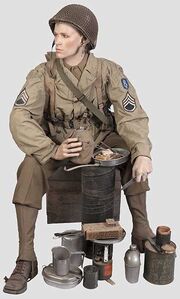
A World War II US Army uniform
In World War II, the same pattern as World War I was repeated. The United States did not get involved when the war started on 1 September 1939 when Nazi Germany invaded Poland, but on 7 December 1941, Japan bombed Pearl Harbor in Hawaii in response to a US oil embargo placed in Japan during the Second Sino-Japanese War. In agreement with their no separate peace policy, Nazi Germany and Italy joined Japan in the war, so the United States joined the Allied Powers. The US Army fought the Imperial Japanese Army in the Philippines in late 1941-1942, and in late 1942, they fought the Germans and Italians in North Africa under George S. Patton. Patton, considered the best US general of the war, drove into Italy and conquered Sicily in a short time, and in 1944 he led the US 3rd Army during the Battle of Normandy, during which he led the breakout from the Normandy Beaches and into the rest of occupied France. His forces advanced through Belgium towards Germany, defeating German forces in the decisive Battle of the Bulge. At the war's end, he pushed into Germany. Meanwhile, the Americans under Mark W. Clark in Italy pushed north and defeated the Germans in Lombardy, and the Americans also liberated the Philippines from Japan that same year. The war ended on 2 September 1945, when the United States made a peace treaty with Japan months after their peace with Germany. The war solved the Great Depression, as the previously-unemployed were put to work, even women. The war confirmed the United States as a superpower, as it also used the first two nuclear bombs against Japan at Hiroshima and Nagasaki.
Korean War[]

The uniform of the US Army during the Korean War
In the aftermath of World War II, US troops were stationed in Western Europe and West Germany, Italy, Japan, the Pacific, and Korea, which was formerly a colony of Japan. Korea was divided between the US Army's occupation in the south and the Soviet Union's occupation in the north, and in 1946, the south became South Korea (a radical anti-communism dictatorship) and the north became North Korea (a communist dictatorship). The two countries fought in 1950 when the North invaded the south to unify the country under communist rule, so the United Nations (established in 1946 to prevent another world war and to keep peace) put together a coalition against North Korea, which was backed by the USSR and China. The United States led the coalition, and the UN forces were victorious after a bloody conflict that saw no territorial gain at the end of the war, with 2,500,000 people dying.
Vietnam War[]
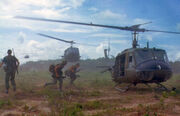
US troops in Vietnam
In 1958, the United States invaded Lebanon to restore order in Operation Blue Bat, and in 1964 the United States joined South Vietnam during the Vietnam War to defend it from a Korea-like situation involving the North Vietnamese and Viet Cong trying to conquer them and unite Vietnam. In 1965, they invaded the Dominican Republic. The Vietnam War was arguably the most unpopular war in US history, with young men as young as 18 being drafted into the army and being sent to fight in Vietnam against a democratically-elected leader, Ho Chi Minh. In 1973, the US withdrew from Vietnam completely after 58,000 deaths, having fought the NVA, Viet Cong, Khmer Rouge, and Pathet Lao.
Peacetime[]
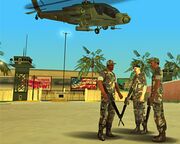
US troops stationed at Fort Baxter National Guard base in Miami, Florida in 1984.
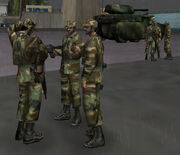
US Army troops stationed at Fort Baxter National Guard base in Miami, Florida in 1986.
The defeat in Vietnam led to the people not trusting the government, especially after the Kent State Massacre. The American people endured an energy crisis from 1973 onwards after OPEC stopped supplying the US with fuel in revenge for their support of Israel during the Yom Kippur War, and the United States was at peace for years. Under President Jimmy Carter, US diplomats were held hostage by Iran in the "Iranian hostage crisis" of 1979 after the USA gave refuge to Shah Mohammed Reza Pahlavi following the Iranian Revolution. His rescue mission, Operation Eagle Claw, failed, and the hostages remained under Iranian control. His successor, Ronald Reagan, would change the way that the military handled things. Under the Reagan administration, he fought against communism everywhere. He gave brutal military dictatorships support in putting down communist guerrillas such as in Argentina, Brazil, Colombia, Peru, Guatemala, and El Salvador, while supporting nationalist rebels against a communist government in Nicaragua. In 1983, he sent troops to invade Grenada after the Grenadian leader Maurice Bishop was assassinated. He also sent troops to keep the peace in the Lebanese Civil War, but after the Beirut barracks bombing which killed 265 American servicemen, he withdrew them in 1984. In 1989, under orders from President George H.W. Bush, the USA invaded Panama, unseating Manuel Noriega.
Gulf War[]
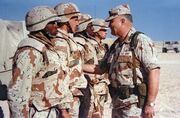
General Norman Schwarzkopf speaking with his troops during the Gulf War in 1991.
In 1990, the US Army was finally able to show off its advanced arsenal in the Gulf War. Since Vietnam, there had not been a major war to test the resolve of the United States against a major foreign power. Ba'athist Iraq invaded Kuwait in August 1990, causing the United Nations to put together a coalition against Iraq, with the USA, United Kingdom, and France leading the UN force. The Americans used cruise missiles and smart bombs to destroy Iraqi positions and bomb their cities, and their ground forces also defeated the Iraqi forces. The ground war ended in a week from 20 February to 28 February, with the US showing off its might.
Yugoslav Wars[]
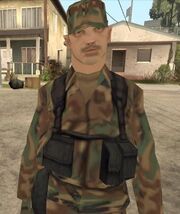
An American soldier in 1992
The US Army later got involved in the Bosnian War of 1992-1995 in Operation Deliberate Force, and although the fighting was carried out by the USAF against Republika Srpska ground forces, US troops remained in Bosnia and Herzegovina as peacekeepers. US troops were briefly deployed to Somalia during the Somali Civil War, but withdrew in 1993 shortly after the Battle of Mogadishu, where they suffered heavily. The US Army also got involved in the Kosovo War in 1999, and they kept the peace, ensuring that the Kosovars were safe from persecution. The US forces deployed on the ground did not fire a shot, but again, their air force bombed enemy positions.
Modern wars[]
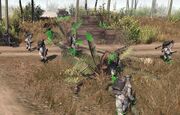
US troops in the jungle
In the meantime, US forces deployed to Saudi Arabia to forestall any Iraqi buildup of arms gained hostility from certain anti-western people. Osama Bin Laden, the son of a Saudi billionaire, was opposed to the presence of US troops close to the Islamic holy sites of Mecca and Medina, and in 1993 he was responsible for a failed bombing of the World Trade Center that killed only a few Americans and did little structural damage. In 1998, two bombings attacked embassies in Kenya and Tanzania, leading to retaliation against his al-Qaeda jihadist group in Sudan and Afghanistan. On 11 September 2001, these attacks reached their climax with the 9/11 terrorist attacks, in which three airline jets were hijacked and crashed into strategic buildings (destroying the World Trade Center and damaging the Pentagon) while a fourth crashed into a field during a struggle between the hijackers and passengers). This led to President George W. Bush ordering an invasion of Afghanistan, as the Taliban government refused to hand Osama Bin Laden and al-Qaeda over to the US government. Only a few US and British troops were sent to Afghanistan to assist the larger Northern Alliance Afghan fighters in overthrowing the Taliban. The Americans and British assisted the Northern Alliance in capturing Kandahar from the Taliban, ending their resistance by December. The brief invasion showed off the might of the US Army again, but the Taliban were funded by an opium harvest in 2003 and resumed an insurgency. The US had counteracted this by assembling a NATO and non-NATO coalition called the International Security Assistance Force (ISAF) from countries across the world, and they occupied Afghanistan. The ISAF fought the Taliban for several years, and the US Army fought in Afghanistan until 2014, when they withdrew in December with the last ISAF troops that had not evacuated earlier.
Iraq War, and the unsuccessful war on terror[]
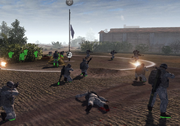
US troops in 2016
In 2003, the United States invaded Iraq after claiming that dictator Saddam Hussein possessed weapons of mass destruction and was linked to al-Qaeda. The Americans again defeated the Iraqis easily, with aid from the UK, Poland, Denmark,South Korea and Spain (France and Germany disagreed with the invasion and abandoned the US). They built up the Multinational Force - Iraq (MNFI), and they fought against a growing insurgency of Sunni insurgents, Ba'ath Party Saddam loyalists, and Iranian-backed Shi'ite insurgents until 2011, when the US left Afghanistan; most of the ISAF left by 2009. The war was a foreign policy issue for the US, with many people in the USA being opposed to the war, as there was no conclusive proof of Iraq having WMDs, and many Americans were dying while fighting in a war that was alleged to be for oil.
Currently, the US Army is not involved in any wars, although advisers help the Afghan National Army (ANA) in training as a part of the Resolute Support Mission, and they are also involved in training the Pakistani Army, whom they have also clashed with a few times on the Afghan-Pakistan border. However, since the Afghan National Army has fallen, there is absolutely no hope of regaining control.



